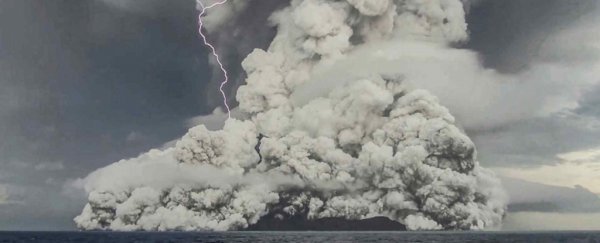The tsunami produced by the Hunga Tonga–Hunga Ha'apai eruption at the start of 2022 hit multiple countries in Oceania, Asia, North America, and South America, with waves up to 15 meters (49 feet) in some locations – the devastating consequence of a volcanic shockwave that broke records.
A new study has now revealed the mechanism that scientists think may have caused the tsunami to travel so far and with such force – a phenomenon known as acoustic-gravity waves (AGWs), a particularly long type of sound wave that can travel extremely quickly through the ocean or the air.
These AGWs apparently traveled through the water, up into the atmosphere and then out across the waves as the volcanic eruption developed, and as multiple waves converged, they gave the resulting tsunami even more energy.
This meant the tsunami got bigger, lasted longer, and traveled further and faster than the event otherwise would have.
"The idea that tsunamis could be generated by atmospheric waves triggered by volcanic eruptions is not new, but this event was the first recorded by modern, worldwide dense instrumentation, allowing us to finally unravel the exact mechanism behind these unusual phenomena," says geologist Ricardo Ramalho from Cardiff University in the UK.
A combination of data logged from sea level, the atmosphere, and satellite readings was used to determine the presence of these waves, and there was a "direct correlation" between the first signs of air disturbance caused by AGWs and the beginnings of the tsunami in several locations.
The Hunga Tonga–Hunga Ha'apai volcanic eruption was a huge one, but underwater eruptions don't usually produce tsunamis on this scale. The scientists think that the way that AGWs excite the ocean-atmosphere interface was crucial in producing such dramatic and damaging results.
Different kinds of violent events can produce AGWs, which – as the name suggests – are affected by the pull of gravity. A single one of these types of waves can stretch to hundreds of kilometers or miles in length, and they can travel down thousands of meters or feet under the water, as well as reaching close to the speed of sound in water.
"The Tonga eruption was in an ideal location below the surface, in shallow water, which caused energy being released into the atmosphere in a mushroom-shape close to the water surface," says applied mathematician Usama Kadri from Cardiff University.
"Thus, the interaction of energetic AGWs with the water surface was inevitable."
When AGWs interact with the tsunamis they've already created, it's known as nonlinear resonance, and the researchers say this was a factor in transferring energy back into the ocean, and amplifying the speed and force of the tsunami even further.
The tsunami traveled 1.5–2.5 times faster than a typical volcano-triggered tsunami, the team estimates, reaching speeds of around 1,000 km/h (621 mph) as it sped across the Pacific, Atlantic, and Indian oceans in less than 20 hours.
What's more, because it was traveling partly through the atmosphere, the tsunami was able to reach the Caribbean and the Atlantic without going around South America first. It seems there's plenty more science we can learn from this hugely notable event.
"Such a resonance at this scale allows us to move beyond proof of concept of the mechanism, and the development of more accurate forecasting models and real-time warning systems, into the potential of developing a new energy harnessing technology," says Kadri.
The research has been published in Nature.
